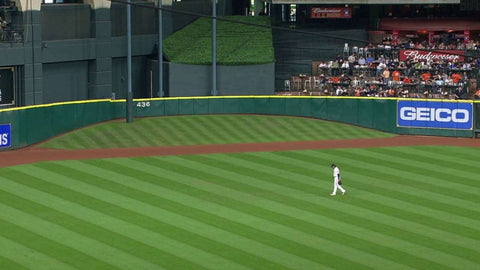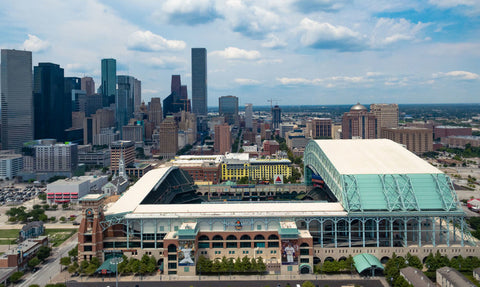Ballpark Profile: Minute Maid Park
Name: Minute Maid Park
Location: Houston, Texas
Opened: 7 April 2000
Architect: HOK Sport
Cost: $250 Million
Capacity: 40,950 (original)
41,168 (present)
Surface: Platinum TE Paspalum (natural grass)
Minute Maid Park -- like several of the other parks we've profiled -- was once our home ballpark.
Thinking about it, here's the complete list of 'home' ballparks:
Oakland Coliseum (1985-1994)
Candlestick Park (1995-1999)
PacBell/AT&T/Oracle Park (2000-2002)
Riverfront Stadium (2002)
Great American Ball Park (2003)
Minute Maid Park (2004)
Coors Field (2005-2006)
New Comiskey Park/Wrigley Field (2006-present)
Citizens Bank Park (future)
So, some personal experience here.
When Minute Maid Park (then called Enron Field) opened, it was universally (and fairly) panned. It was gimmicky to the extreme, with the ill-fated "Tal's Hill" and in-play flagpole in center field -- which originally extended to an eye-popping 436 feet.

Both the hill and the flagpole seemed to be there just for the sake of being there, and both were (thankfully) scheduled for removal during the 2015-16 offseason. (The Astros made the postseason in 2015, which disrupted the timeline, and the hill was not removed until the start of the 2017 season.)
Like Camden Yards and Petco Park, the design for the ballpark incorporated an existing structure, in this case Union Station, a train station built in 1911, which was one of the busiest rail hubs through the end of World War II. The station is now the main entrance foyer for the ballpark, with team offices upstairs.


The train motif continues with a larger-than-life steam engine that runs along the tracks of the large retractable roof. The train runs and sounds its horn after Astros home runs. Sure, it's gimmicky, but fans (especially kids) love it. And the guy who runs it is the best kind of hometown fan.

And so we get to it: the roof.
First, the outside aesthetics. The roof and supporting structure of acres of glass wall are not unatrractive to look at; but the color scheme is. Scroll back to the previous ballpark profiles of Chase Field, Citizens Bank, Miller Park . . . it's like MLB got an unlimited supply of weird turquoise/teal paint and they just can't stop using it.

I don't get it. I don't like it.
As for the criteria that makes a good ballpark: Minute Maid checks many of them: it's right downtown, which is good. It's easily accessible with several public transit options. It fits the aesthetic of the neighborhood (after a fashion), and the fan experience is better-than-average, especially the outstanding food options.
And, when the roof is open, it's a really nice place to see a ballgame.
But. The. Roof. Is. Never. Open.
It's funny; if you search for images of Minute Maid Park, a number of in-game shots with the roof open show up, and they look great. But I lived there for two years, and never once was the roof open for a game. Nobody I've talked to has ever been to a game with the roof open.

It's a completely different feel with the roof closed. It's dark, it's artificial-feeling.
Believe me, having lived there, I know Houston has some incredibly unpleasant, even unsafely hot summer days. And, by all means, the roof should be closed in those events. It also gets more than its share of summer rainstorms.
But, if it's just a warm/hot day? Open the dang roof. People across the country love sitting out on a warm evening watching baseball. It gets plenty hot in Cincinnati, and St. Louis, and . . . almost everywhere baseball is played. I've been to some extremely warm games in the bleachers at Wrigley.
That's part of the fun.
Just because you can close the roof doesn't mean you should.
Have your own thoughts and feelings about Minute Maid Park? Put them in the comments below for a chance to win a FREE PRINT from Ballpark Blueprints!
